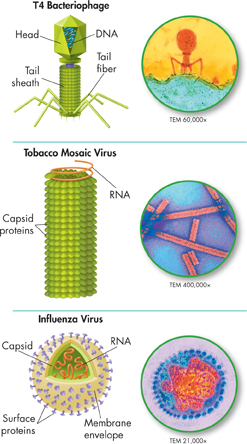Structure and Composition Viruses differ widely in terms of size and structure, as you can see in Figure 20–1. Most viruses are so small they can be seen only with the aid of a powerful electron microscope. The protein coat surrounding a virus is called a capsid. In addition, some viruses, such as the influenza virus, have an additional membrane that surrounds the capsid. The simplest viruses contain only a few genes, whereas the most complex may have hundreds of genes.
To enter a host cell, most viruses have proteins on their surface membrane or capsid that bind to receptor proteins on the cell. In either case, the proteins “trick” the cell to take in the virus, or in some cases just its genetic material. Once inside the cell, the viral genes are eventually expressed and may destroy the cell.
Because viruses must bind precisely to proteins on the host cell surface and then use the host's genetic system, most viruses infect only a very specific kind of cell. Plant viruses infect plant cells; most animal viruses infect only certain related species of animals; bacterial viruses infect only certain types of bacteria. Viruses that infect bacteria are called bacteriophages, which literally means “bacteria eaters.”

FIGURE 20–1 Diversity of Viral Forms Viruses come in a wide variety of sizes and shapes. Three types of viruses are shown here. Interpret Diagrams What kind of nucleic acid does each virus type have?
dQuick Lab
GUIDED INQUIRY
How Do Viruses Differ in Structure?
1 Make models of two of the viruses shown in Figure 20–1.
2 Label the parts of each of your virus models.
3 Measure and record the length of each of your virus models in centimeters. Convert the length of each model into nanometers by using the following formula: 1 cm = 10 million nm. 
4 Measure the length of each virus you modeled. Divide the length of each model by the length of the actual virus to determine how much larger each model is than the virus it represents. 
Use Models Which parts of your models are found in all viruses?
Draw Conclusions Which parts of one or both of your models are found in only some viruses?
Calculate How many times larger are your models than the viruses they represent?

Analyze and Conclude
Table of Contents
- Formulas and Equations
- Applying Formulas and Equations
- Mean, Median, and Mode
- Estimation
- Using Measurements in Calculations
- Effects of Measurement Errors
- Accuracy
- Precision
- Comparing Accuracy and Precision
- Significant Figures
- Calculating With Significant Figures
- Scientific Notation
- Calculating With Scientific Notation
- Dimensional Analysis
- Applying Dimensional Analysis




